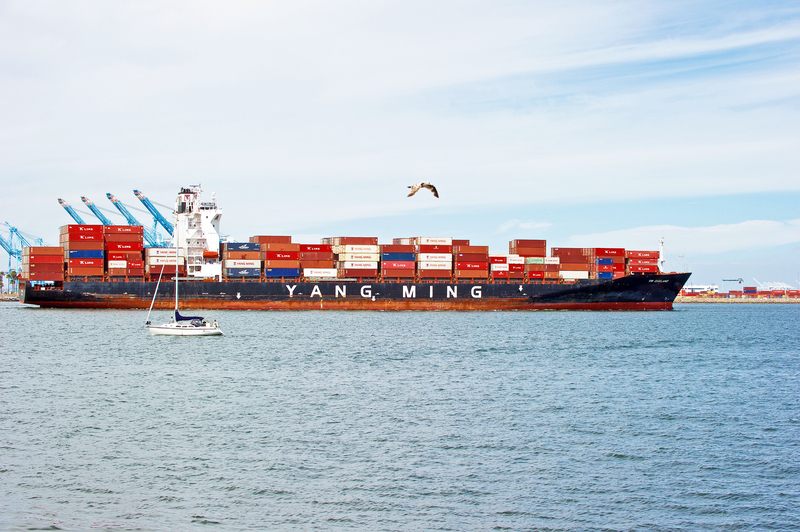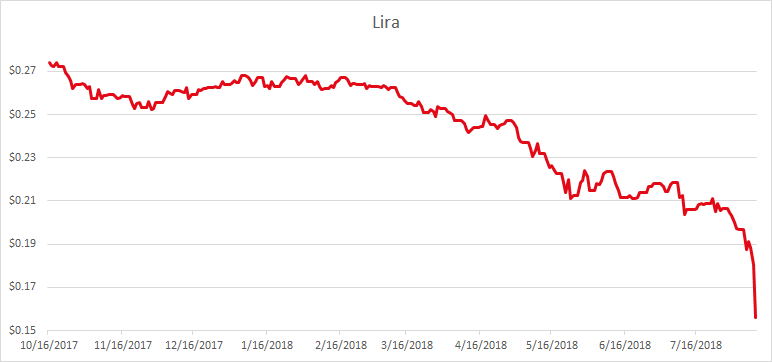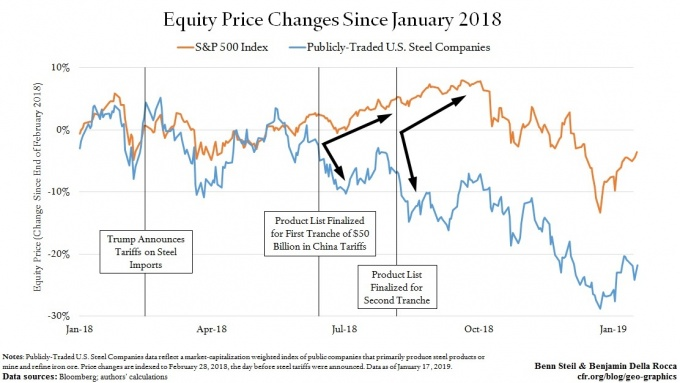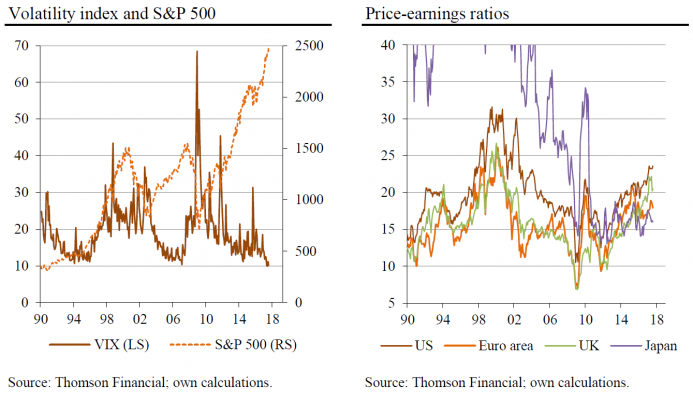
- By Tatiana L. Palermo
The United States was never truly fond of free trade agreements (FTAs). Since 1984, the U.S. has signed FTAs with only 20 countries, the most significant of which was the North American Free Trade Agreement (NAFTA), recently replaced with the United States-Mexico-Canada Agreement (USMCA). In comparison, the European Union has the world’s largest network of preferential trade agreements, having such pacts in force with 77 countries.
At the same time, for decades, the U.S. has been one of the most open economies in terms of trade, applying import tariffs that are among the lowest in the world. According to the World Trade Organization (WTO), its average applied import tariff in 2019 was 3.3 percent, compared to the EU’s 5.1 percent and China’s 7.6 percent. Even considering the recent wave of trade protectionism, with the imposition of higher tariffs on goods imported from its major trading partners, the U.S. average import tariff remains low.
The U.S. policy of unilateral tariff reduction under its Generalized System of Preferences (GSP) is a big reason for this state of affairs. Today, the GSP grants trade preferences to 119 developing and less-developed countries. Emerging economies like Brazil, Indonesia, Argentina and South Africa are among the program’s current beneficiaries. India and Turkey had been removed from the list last year.
President Donald Trump’s administration prioritized economic nationalism, criticizing FTAs negotiated by previous governments as unfair and forcing the renegotiation of NAFTA. Even though the U.S. formally launched negotiations with the EU last year, it is doubtful that the talks will result in a comprehensive free trade agreement. The other two ongoing negotiations – with the United Kingdom and Kenya – have better chances, but considerable progress in the short term is unlikely. The U.S. will probably continue to move away from bilateral free trade agreements in its future trade policy.
Level playing field
In his August 2020 op-ed in The Wall Street Journal, U.S. Trade Representative Robert Lighthizer expressed his strategy for “How to Set World Trade Straight.” He argues that in many cases, free trade agreements codify protectionism and undermine the core WTO principle of most-favored-nation (MFN). Under MFN, countries cannot (under normal circumstances) discriminate between their trading partners: if one country grants trade preference to another, they must do the same for all other WTO members. Free trade agreements and special trade preference systems for developing countries (like GSP) are exceptions to this rule allowed by current international trade norms.
Mr. Lighthizer reckons that successful multilateral market access negotiations aimed at reducing MFN tariffs ended with the creation of the WTO in 1995. After that, he pointed out, countries started to “advance their interests through litigation rather than negotiation” and focused on signing bilateral trade deals.
The chief U.S. trade negotiator argues that countries should abolish free trade agreements, except for “agreements intended to foster regional integration among contiguous states” (like USMCA and the agreement governing trade within the EU). In other cases, the WTO members should be required to extend trade preferences negotiated bilaterally to all other members, granting them the MFN treatment.
Defending a level playing field and equal rules for all, Mr. Lighthizer also suggests the abolition of special treatment for developing countries, especially large emerging economies. He proposes that WTO members agree on baseline tariff rates that apply to all, using benchmark rates based on the average tariffs in industrialized countries, “with limited deviations for each member to address its own political sensitivities.”
Following the MFN strategy, last month, the U.S. and the EU decided to extend tariff reductions agreed bilaterally to all other WTO members. (The EU agreed to eliminate import tariffs for U.S. live and frozen lobster products, and the U.S. agreed to reduce its tariff rates by 50 percent on select European products, including some prepared meals, certain crystal glassware, surface preparations, propellant powders, cigarette lighters and lighter parts).
China and the WTO
The leading cause of U.S. frustration is that the WTO failed to restrain China’s unfair economic activities. China’s accession to the WTO in 2001 marked the beginning of an enormous transformation in the multilateral trade system. At the time, the U.S., the EU and other industrialized economies actively supported Chinese membership. They believed that more openness to trade would lead to a political transformation, with Beijing accepting Western liberal values such as free markets, limited government and human rights protection. But instead of the WTO changing China, China changed the WTO.
Only a few years after its accession to the organization, China became the world’s factory, buying primary commodities from other countries, turning them into manufactured goods and then exporting them all around the world. The phenomenon significantly altered the logistics, as more goods started to cross the oceans. The share of trade in global GDP increased from 51 percent in 2000 to 60 percent in 2019.
In 2010, China became the world’s second-largest economy, after the U.S. It achieved this status without significantly changing its political and economic system, remaining a centrally planned economy with substantial state subsidies. It retained its plethora of state-owned enterprises, kept its low labor and environmental standards, and engaged in systematic intellectual property rights violations and forced technology transfers. All this came in addition to infringements on individual rights. Meanwhile, China made significant territorial and military advancements.
According to a recent statement made at the WTO by the U.S. and Brazil, such nonmarket-oriented policies “damage the world trading system and lead to severe overcapacity, create unfair competitive conditions, hinder the development and use of innovative technologies, and undermine the proper functioning of international trade.”
The fundamental differences between today’s first- and second-largest economies in terms of market-openness and liberal values, coupled with the WTO’s tradition of making all of its decisions by consensus, have contributed to a deadlock over important issues. Today, most WTO members agree that the organization needs reform. The only question is whether Chinese and Western economic systems can peacefully coexist.
Scenarios
The U.S. continues to block new WTO Appellate Body appointments, effectively killing the enforcement of international trade rules. Washington is determined to bring about what it calls “real” WTO reform, including a new dispute settlement system (Mr. Lighthizer proposes a “single-stage process akin to commercial arbitration”). Recently, China has warned that the impasse will eventually reduce members’ willingness to negotiate new rules.
It is unlikely that the coming U.S. presidential elections will change the country’s stance on trade issues. Trade policy is not a priority for the Democratic candidate, former Vice President Joe Biden. His platform states: “we will not negotiate any new trade deals before first investing in American competitiveness at home.” If elected, Mr. Biden will continue policies against Beijing, maintaining or even increasing tariffs for imported goods from China and other trading partners. The trade dispute with China, and trade protectionism in general, have gained broad bipartisan support.
As for a possible second Trump administration, if Mr. Lighthizer’s strategy is applied, the U.S. will further increase tariffs, bringing them closer to other industrialized countries’ levels. Washington will probably continue pursuing managed trade strategies by forcing trade partners to cap exports of certain goods (to protect American producers) and signing agreements like the Phase One trade deal with Beijing, which requires China to purchase more U.S. goods. Such agreements violate international trade rules and are even more discriminatory for nonparticipating members than traditional free trade pacts.
While countries are unlikely to stop negotiating bilateral trade deals (the number of regional trade agreements in force has more than tripled since 2000 and continues to grow), the impasse at the WTO risks pushing the multilateral trade system even deeper into the abyss.
The Covid-19 pandemic caused countries to question China’s dominance in global manufacturing, especially in sensitive sectors like medical supplies, intermediate manufactured products and rare earth elements. It also widened the West’s divide with China over technology. Many countries have announced import-substitution policies and significantly increased state aid.
For geopolitics and global trade, there are several probable consequences. For one, economic nationalism and trade protectionism will slow the post-pandemic economic recovery. Consumers around the world will face higher prices, and poverty will grow. Companies will face increasing disruptions in their global production chains and in finding new markets for their products. Trade wars will increase political and economic divides and make the world less safe.
Without enforcement of international trade rules, the future of free trade does not look bright.
Tatiana L. Palermo is an International Trade, Public Policies and Regulatory Advocacy expert. She chairs Palermo Strategic Consulting LLC based in Washington DC, USA.
Source: https://www.austriancenter.com/the-future-of-free-trade/



